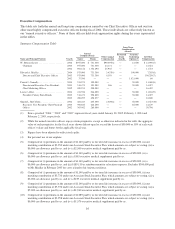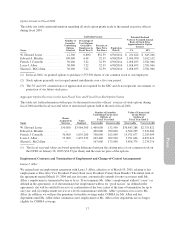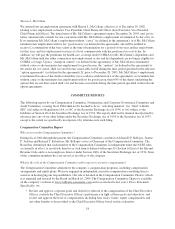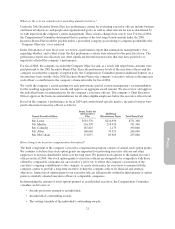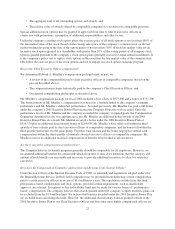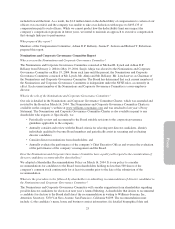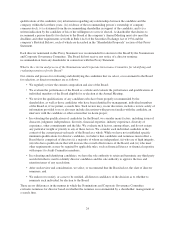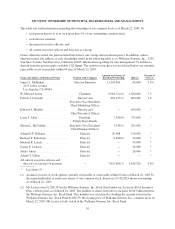Pottery Barn 2004 Annual Report Download - page 97
Download and view the complete annual report
Please find page 97 of the 2004 Pottery Barn annual report below. You can navigate through the pages in the report by either clicking on the pages listed below, or by using the keyword search tool below to find specific information within the annual report.How many times did the Compensation Committee meet during fiscal 2004?
The Compensation Committee held a total of three meetings during fiscal 2004, in March, August and
November. At certain of these meetings, our Chief Executive Officer made recommendations to us with respect
to the compensation adjustments for other executives and with respect to the structure and terms of these
officers’ target bonuses and equity-based compensation arrangements. However, our Chief Executive Officer did
not participate in the portions of the meetings during which his own compensation was deliberated.
Do we compare the company’s compensation practices to those of other companies?
Yes. We believe that the compensation practices of many different companies within the retail industry are
relevant to establishing the company’s compensation programs and executive compensation for each year.
Specifically, we strive to ensure that the company’s compensation programs and executive compensation are
competitive, taking into account pay practices at other companies considered by us to be comparable each year,
based on industry, revenues and other factors. We refer to these companies collectively as “comparable
companies.” For fiscal 2004, the comparable companies included over 30 specialty retail companies with similar
annual revenue. We relied on executive compensation benchmarking surveys that provided summarized data
levels of base salary, target annual cash incentives, and equity-based and other long-term incentives. We believe
that among the comparable companies, survey data in these areas provide, by and large, a reliable indicator of
total compensation. In addition, the company utilizes an independent executive compensation consultant hired by
management for the purpose of meeting with us to provide information on the competitiveness of the company’s
compensation programs. The Compensation Committee met periodically throughout the year to review, discuss
and analyze the data.
How are base salaries determined?
We review and set the company’s executive officers’ base salaries, including those of the named executive officers,
on an annual basis. This review occurred in March 2004 to confirm appropriate base salaries for fiscal 2004.
We believe that executive officers’ base salaries must be sufficiently competitive to attract and retain key
executives. Accordingly, base pay and annual increases are determined through an analysis of each individual’s
salary and total target compensation relative to salaries for similar positions at comparable companies and, to a
lesser extent, through a subjective analysis of each individual’s experience and past and anticipated contributions
to the company’s success. As a result, for fiscal 2004, the company’s executive officers’ base salaries fell
generally within the third quartile (i.e., 50th to 75th percentile) of similarly situated executive officers at
comparable companies.
How are annual incentives determined?
The company promotes outstanding performance by rewarding executive officers for achieving specific
performance objectives with an annual cash bonus paid through the company’s 2001 Incentive Bonus Plan or, in
some cases, through discretionary bonuses granted outside of the plan. The company pays bonuses under the plan
only when the company exceeds a specific corporate earnings objective as established by us in the first quarter of
each fiscal year. Bonuses to executive officers, whether granted within or outside of the 2001 Incentive Bonus
Plan, are based on the company’s performance and on each executive officer’s individual performance. If the
company or the executive officer fails to fully meet some or all of the company or individual objectives, the
award may be significantly reduced or even eliminated. Conversely, if the objectives are overachieved, awards
may be significantly increased above target thresholds set under the 2001 Incentive Bonus Plan pursuant to the
pre-determined formula and maximums of the plan.
The executive officers’ bonus target under the 2001 Incentive Bonus Plan was within the third quartile of annual
incentive bonus targets of similarly situated executive officers at comparable companies. The executive officers’
base salaries and the bonus target together place annual cash compensation within the third quartile of similarly
situated executive officers at comparable companies. In March 2004, we established a 2004 target annual
incentive amount under the 2001 Incentive Bonus Plan (the “target bonus”) for all of the company’s executive
officers, including the Chief Executive Officer.
20








